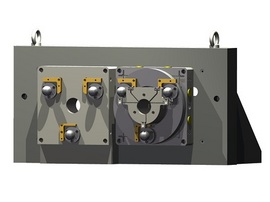 |
Date Announced: 18 Aug 2014
Applications in basic research, medical science and industry
Ultra-short pulsed lasers are no longer used mainly in the laboratories of basic researchers. They are an important part in the industry for cutting, surface finishing and pattern recognition and also in medical science. In medical science amongst others they are in place for the detection of cancer cells.
Specialized microscopes combined with the ultra-short pulse laser reach a higher resolution. Therefore it is possible to differ healthy cells from cancer cells.
Definition of the project
In an experimental set-up for the generation of high energy ultra-short pulsed lasers lithographically produced gratings need to be adjusted within a few nanometers each to another. These gratings decompose and assemble the laser spectrally. The adjusting degree of freedom needs to be smaller than 70 nm or 80 µrad. Where the adjustable mass can weigh up to 20 kg (44 lbs), a 5-axis control (3 rotary and 2 translational axes) is necessary to adjust the laser under these conditions. Because of the control it is possible to monitor the position of each degree of freedom. The reached position has to be long-term stable with uncertainties of a few nanometers. Otherwise a modular set-up is required.
In an experimental set-up with a hexapod system these specifications could not be achieved. Hexapod systems allow an easy multidimensional adjustment but the long term stability in nanometer scale is very difficult. In consequence the customer decided against the hexapod solution.
To reach the required long term stability the new solution from piezosystem jena is very compact. In a first work step all the 5 axes can be positioned within single figure microns. Based on the accuracy of the first positioning piezo actuators with a high stiffness and stability but small motion can be used for fine tuning. The solution is well suited to build in a modular way.
Basic advantages of the adjusting device
Controlled motions of single figure nanometers have been tested and confirmed in a first laboratory set-up. With an active adjustment control these parameters can theoretically be hold for an infinite time. Single steps scaled down to 1 nanometer could be realized without any risk.
E-mail: tkuntze@piezojena.com
| © 2025 SPIE Europe |
|